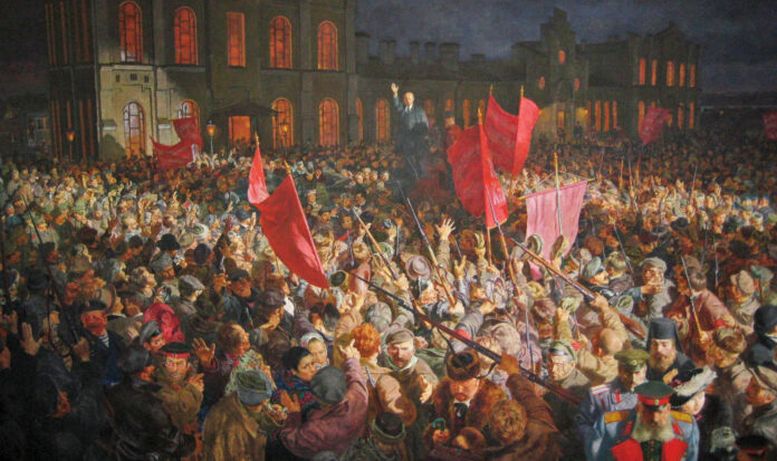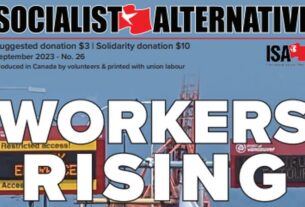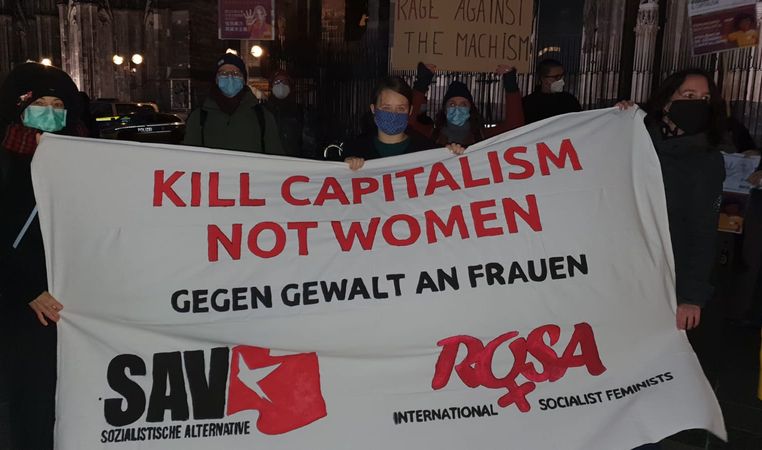Young people today are living in a world rife with crisis. The cost-of-living crisis, numerous wars, and a killer climate, just to name a few. It’s no wonder huge sections of young people have absolutely had it. Out of the experience of living through the tumult of this period, many are realizing that we need to fundamentally transform society.
There is a growing openness to socialism and communism among young people who recognize the need to do away with capitalism. Last spring, the Harvard Youth Poll found that only 9% of 18-29 year olds think the country is moving in the right direction. A YouGov 2020 poll showed that 57% of Gen Z and 60% of millennials in the US favour a complete change of our economic system away from capitalism and that 30% of Gen Z and 27% of millennials have a favourable view of Marxism.
However, it’s not enough to be anti-capitalist. Revolutionary socialists argue that the economy can’t be left in the hands of the corporate elite and out-of-touch politicians, who pocket the profits made off the backs of working people. Society runs off our labour, and we know what’s best for our workplaces, schools, and communities. Making society truly democratic, where everyone’s needs are met, will take a political revolution that takes power out of the hands of the rich, and replaces it with public ownership and full democratic control by the working class.
This includes democratic public ownership of key industries and the banks, a planned economy, guaranteed quality public housing, healthcare, transportation, and education for all with a sharing out of work. This means having leaders who are actually accountable, take the average worker’s wage, and are directly recallable. But a socialist transformation of society is fundamentally not possible without going beyond the capitalist system, which will take an almighty clash with the capitalist class.
Why Can’t We Make Capitalism Work?
It can seem like it would be a lot easier to just reform capitalism into a kinder, friendlier, less exploitative version of itself – an idea which Marxists refer to as reformism. While some reformists claim to want revolutionary change in a dim and distant future, others claim that if the working class is organized as a powerful force in society, then you don’t need to take the economy out of the hands of the capitalist class, but can simply force the capitalists to make society better.
The problem is that the working class can’t simply take a primary tool the capitalist class uses to maintain its rule – the capitalist state (which means the government, the police, and other similar institutions) – and use it for our own purposes by winning reforms to make capitalist society somewhat less exploitative. As long as billionaires and massive corporations remain in control – as long as capitalism remains the economic system of society – the market-driven rush for profits will inevitably claw back any pro-worker reforms. Worse, if the working class does try to take control of the state while leaving capitalism intact, as typified in the example of Chile in 1973 and Venezuela today, the bosses can use their wealth, political power, and the police (and army!) to overthrow a pro-worker government if they feel it has gone “too far” in reshaping society.
In the US, our most recent experience with reformism on a mass scale was Bernie Sanders. The central idea of the Bernie campaign was a political revolution against the billionaire class, a message that mobilized millions of young and working people wanting to break with the status quo. But Bernie wasn’t talking about an actual revolution, and he ultimately capitulated to the capitalist Democratic Party.
The enormous political potential of Bernie’s movements were blocked by the Democratic Party leadership both in 2016 and 2020. Both times, Socialist Alternative argued for the need for Bernie to break with the capitalist, corporate-backed Democrats and launch a new independent political party for the working class. A mass workers’ party would need to be free from corporate cash, rooted in unions and movements, with a program that is democratically decided on and candidates that are actually accountable. But as a workers’ party fights for reforms, it brushes up against the limits of what capitalism can offer, which is why an explicitly revolutionary party is ultimately needed to get rid of the system once and for all.
However, elections are neither the central nor the best tool we have, and can’t be the end-goal in themselves. Winning an election is just the beginning of a new stage in the fight to expose the true nature of the parties of the capitalist class and their “democracy”. The bosses will never let the majority of people vote on things that could truly transform our lives, like voting to veto a declaration of war, to end racist policing or mass incarceration, or to nationalize the top 500 corporations and take them under democratic workers’ control, just to name a few.
Why Socialists Must Be Internationalists
The task of building a united, international movement to overthrow the capitalist system and build a socialist world is challenging, but absolutely necessary. Capitalism strangles the whole world; it’s not possible to beat it in one country and build a new and better system in isolation. The capitalists would use the vast resources at their disposal to defeat any challenge to their system, even uniting across borders to wage all-out war against any country where the working class took power. It will require socialist revolution around the world in order to usher in an era free of capitalist oppression.
Working people everywhere have more in common with one another than they have with the billionaires of their own nation, and it is our task as socialists to drive home that point.
Furthermore, the crises caused by capitalism, like the climate catastrophe, are caused by a drive for profit that is completely global, and will require a coordinated global solution. In the US, Biden has continued and expanded Trump-era drilling, and has committed to increased weapons production (one of the largest sources of pollution in the world) to serve the interests of US imperialism. Meagre reforms in the US, such as the production of electric vehicles, are no counterweight to the existential crisis we face. Without global cooperation through an international planned economy, there is no real chance at stopping climate change.
Does Russia Prove Socialism Can’t Work?
A socialist revolution anywhere represents a threat to the capitalists everywhere. As revolutionary socialists, we look to the example of the Bolsheviks in Russia, but we also are aware that many people have misunderstandings or concerns about the example of the USSR, in no small part due to the role played by the Stalinist bureaucracy.
The Soviet Union started off as a state genuinely led by the working class, which had overthrown capitalism and taken power. Under workers’ control, land was nationalized, housing and healthcare were provided, abortion was free and legal, and LGBTQ people and women were granted full rights.
However, due to its international isolation, underdeveloped industries, and the fact that it had to defend against the invasion of over twenty capitalist armies trying to overthrow its worker’s state, the revolution degenerated. The underdevelopment of Russia at the time really can’t be understated; only around 40% of the population had any degree of literacy at all, and literacy among the workers and peasants was lower still. Also the vast majority of the country were peasants, while the working class was only 8% of the population (although very powerful due to their concentration in large factories).
Faced with this level of underdevelopment – with no help from abroad – the working class was forced to leave many bureaucrats from the old Tsarist regime in their roles. This bureaucracy was eventually able to consolidate power and conduct repeated purges of the working-class leaders of the revolution. It seized an opportunity to take power into its hands, with Stalin at its head. Stalin advanced the theory of “socialism in one country” – the opposite of Marxist internationalism.
Rather than focusing on an international socialist revolution to develop the economy of the USSR, Stalin first reintroduced parts of capitalist exploitation, telling rural landlords to “enrich themselves”. Then later Stalin zig-zagged in the other direction and turned towards gulags and forced labour to modernize the USSR.
The bureaucracy shut down the power of workers committees (soviets) from running society. It ended the democratic rights of the working class in Russia by ending its ability to govern through working-class control over the state economy. Trotsky launched the Left Opposition to oppose this, but Stalin’s fumbling of other international revolutions like in China in 1927 actually strengthened the Soviet bureaucracy.
As the only viable alternative to capitalism, Stalinist ideas shaped all revolutions that followed. In China in 1949, a peasant army led by Mao Zedong overthrew a vicious capitalist class linked to colonial exploitation. As a government, the Chinese Communist Party had a dismissive attitude towards the working class and internationalism, instead developing their national economy by relying on imperialist countries like the US. The Chinese Communist Party is now essentially the ruling class of Chinese capitalism, and its leader Xi Jiping is a multi-billionaire.
Different variations of Stalin’s counter-revolutionary theory of “socialism in one country” shaped revolutions in Cuba, Vietnam, North Korea, Cambodia, and more. Even explicitly non-Marxist groups like the Ba’ath Party in Iraq and Syria, Ghaddafi in Libya, and many other former colonial countries leaned on the bureaucratic features of the Stalinist USSR to develop their economies, and today all these countries are capitalist with their own ruling classes and their own forms of vicious exploitation. What made all of this possible was a deadly hostility to genuine Marxist internationalism.
The Need for Democratic Workers’ Control
Nevertheless, the experience of the USSR’s planned economy demonstrated to many workers around the world the viability of a planned economy not governed by the profit motive. Within the span of a few decades, the USSR’s planned economy took many of the most underdeveloped countries in the world and rapidly brought them up to speed with the rest of the industrialized world.
In fact, in some areas the USSR even outstripped the capitalist countries in terms of advancement. For example: in the first few decades of the USSR, life expectancy dramatically rose to eventually equal that of the US. This was in part influenced by the large emphasis placed on improving medical care in the Soviet Union; by the 1970’s the USSR had more doctors and hospital beds per capita than the United States. The USSR also began to technologically rival imperialist powerhouses like the US, and in some cases even outstripped them, like in the 1960s when the USSR became the first country to put a satellite in space.
There have been many attempts to transform society in the image of the bureaucratic Stalinist USSR, with state control of the economy, but without the working class itself actually wielding political power. Examples of this are states built on the Stalinist model from the very beginning, such as China prior to the restoration of capitalism in the late 20th century, and also Cuba. These examples demonstrate that a planned economy needs democratic control by the masses in the same way a human body needs oxygen.
Decades of suffocating repressive bureaucratic rule and mismanagement by Stalinist regimes has often led to economic stagnation and even regression, with workers’ living standards falling and shortages of many basic items. These so-called communist dictatorships’ use of socialist terminology to justify their misdeeds discredited socialism among big sections of the population globally.
The Role of The Working Class
In the modern era, the only force capable of changing the world and overthrowing capitalism is the united working class. Our definition of the working class includes all those who work for a living and receive wages or salaries in exchange for their labour. The power of the working class is clearly evident during outbreaks in the class struggle, such as the UAW Big Three auto strike in 2023, the current Amazon unionization drives, and the large numbers of nurses and teachers moving into struggle.
Strikes, especially mass strikes, along with demonstrations and campaigns for reforms, can play a critical role in challenging the power of the capitalist class and showing workers and young people everywhere what is possible. General strikes and uprisings are among the sharpest weapons of working class liberation. However, these outpourings of energy can be dissipated unless they are successful in winning tangible gains. The capitalist class and its political servants do everything they can to confuse, curb, or crush the movement.
It is due to the often chaotic and fast-paced nature of revolutionary struggle that revolutionary leadership must be steeled before revolution breaks out. The Russian Revolution showed that the working class needs to develop revolutionary leadership – an organization made up of the sections of the working class, oppressed, and youth. We call this the revolutionary party. This party needs to be embedded deeply in the movements of working and young people, and most especially in the labour movement through the established unions.
It needs to have a clear set of ideas, a clear program, that can combat the ideas the bosses use to distract and divide workers like racism, sexism, and other forms of oppression. If carried out correctly, the revolutionary leaders in this party would then be positioned, during a powerful or revolutionary movement, to point to the need for the working class to overthrow capitalism entirely in order to win any real, long-term gains.
The party we need to build needs to not only be present in the workplace fighting on issues of pay, but would also need to take up the fight against all forms of oppression, the fight against war and imperialism, the fight against climate change, and all the other crises of capitalism. It must be opposed to the parties of the bosses, exposing their lies and shortcomings, as opposed to working with them in a cross-class partnership. The revolutionary party would need to play a leading role in social struggle alongside the rest of the working class – however it is the inherent power of the larger working class, not the revolutionary party itself, that can transform society.
Socialist Alternative is a revolutionary organization that aims to develop working-class leaders to prepare to take part in forming the revolutionary party that can help lead the working class to victory. We are part of International Socialist Alternative, which has sections all over the world.
Developing capable revolutionary leadership is one of our primary tasks today, alongside rebuilding the broader left and the labour movement. These are not simple matters; at times it can seem like the task before us is too great to ever be achieved. Before revolutions happen, they seem impossible. In their aftermath, they seem to have always been inevitable.
The truth is that a future where humanity is liberated from the oppressive yoke of class society is neither impossible, nor guaranteed. We can shape the future only through active struggle against the oppressor class. The crises of capitalism are brewing what could be its greatest catastrophes yet, and the workers and young people of today have a choice to make: whether we will declare the fight hopeless before its greatest battles even arrive, or whether we will take up the fight to free humanity from exploitation and oppression and build a new world.




